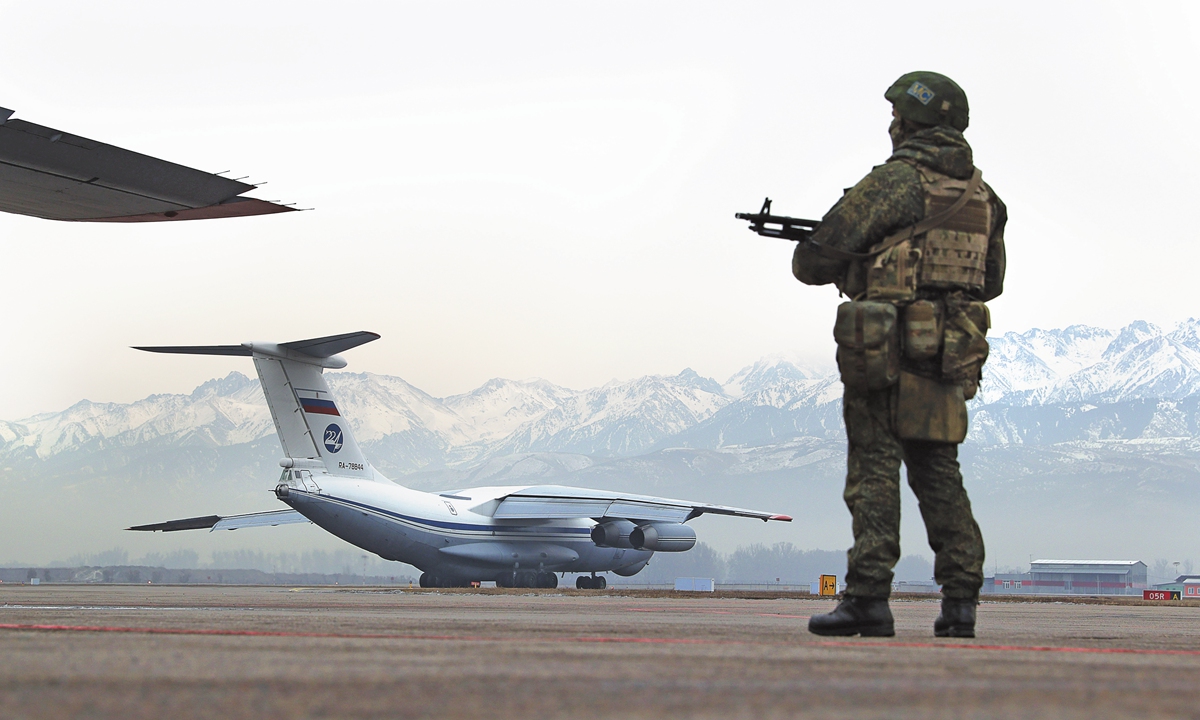अगाडि >> World News
‘Three Evil Forces’ continue to lurk in shadows of riots, color revolutions in Central Asia: experts
World News 2022-02-20 10:41:1313854Nepal International NewNewsCenter

A homebound Ilyushin Il-76 strategic airlifter carrying Russian peacekeepers on board takes off from Almaty International Airport. Photo: VCG
Terrorism, extremism, and separatism, known as the "Three Evil Forces" have long been an unstable factor in Central Asia. Traces of these forces are once again seen in the latest regional security failure in Kazakhstan.The large-scale riots in Kazakhstan started as demonstrations, but were soon taken advantage of by extremist and terrorist groups, and were gradually turned into riots.
Kazakh authorities linked the violent protest to extremist groups, saying that preliminary data shows the attackers include individuals who have military combat zone experience in the ranks of radical Islamist groups, local media the Astana Times reported. The Kazakh government claims the number of terrorists involved in the riots is probably around 20,000.
Whether or not the "Three Evil Forces" are the main cause of the current unrest in Kazakhstan, scholars point out that they have been one of the biggest security risks in Central Asia for nearly a decade.
'Three Evil Forces' in Central Asia
"The unrest in Kazakhstan has once again revealed that some people were being paid to participate in riots on the streets, and they were likely funded by the West or the Three Evil Forces," Pan Guang, a senior expert on counterterrorism and Afghan studies at the Shanghai Academy of Social Sciences, told the Global Times.
Although the "Three Evil Forces" are not the only root of Kazakhstan's latest riots, the forces apparently took advantage of the existing instability, Zhu Yongbiao, director of the Center for Afghanistan Studies in Lanzhou University, told the Global Times.
Scholars noted that after the September 11 attacks, Central Asia became the epicenter of the "Three Evil Forces."
Pan referenced a typical case in May 2011, when thousands of workers from Kazakhstan's oil and gas sector started three separate labor strikes that then developed into clashes with security forces that resulted in mass casualties.

Street view of Almaty, Kazakhstan through a broken window after protests in the city in early January 2022 Photo: VCG
Nazarbayev's government at the time accused the strikes and protests of being instigated by anti-government forces outside the country, said Pan."We later found, in our research, that Jund al-Khilafa was behind it. The group, whose participants are mostly young men, attempted to overthrow the government of Nursultan Nazarbayev and 'establish an 'Islamic Caliphate,'" Pan said.
Terrorist activities in Kazakhstan have been at a high level since 2011, which is related to the increase in terrorist organizations around the country, Wang Yuting, an associate researcher at China Institute of Frontier Studies, Chinese Academy of Social Sciences told the Global Times.
The Kazakh government went all in to contain extremist organizations within the country, amending laws, stressing management of religion, and collaborating with international organizations, Wang explained.
According to media reports, in 2019, the Kazakh police successfully foiled three terrorist attack attempts, dismantled seven extremist groups, arrested more than 140 militants, and seized a number of guns, knives, and explosive devices. From January to July 2020, 33 terror-related crimes were committed in the country.
Kazakhstan, but the entire Central Asian region has been plagued by the activation of the "Three Evil Forces" in recent years.
Zhu pointed out that the number of attempted terrorist attacks and extremist cases in Central Asian countries solved has been increasing in recent years.
Tajikistan's police solved 1,211 terror-related crime cases in 2019, 338 more than in 2018. Police identified and arrested more than 100 members of terrorist organizations in various operations.
The security services of Kyrgyzstan and Uzbekistan have also stepped up efforts to combat terror-related crimes, arresting dozens of suspects involved in terrorist activities.
According to reports, there were about 2,000 Central Asian extremists in the IS in 2016, including about 500 from Kyrgyzstan and 300 from Kazakhstan. Many others joined the Islamic State - Khorasan Province, a branch of the IS in Central Asia. According to media reports, with the IS' setbacks in the Middle East, some jihadists have begun to secretly return to Central Asia.
Moreover, online propaganda about the "Three Evil Forces" in Central Asia has also become more common.
Since around 2015, groups like the "Jund al-Khilafa" have mostly stopped directly launching riots, but have turned to spreading "jihadist" videos on the Internet to spread cyber terrorism. At the time, a batch of video materials was also sent from Kazakhstan to China's Xinjiang Uygur Autonomous Region.
During several terrorist attacks in Xinjiang in 2014 and 2015, some jihadist videos came from Kazakhstan and Kyrgyzstan, experts noted.
Rising security risks
Ever since the collapse of the Soviet Union, five Central Asian countries have been hit hard by religious extremism, and since the rise of the Islamic State (IS%2
अघिल्लो:Scene of the crime
अर्को: Australia COVID-19 infections hit record amid runaway Omicron outbreak
अर्को: Australia COVID-19 infections hit record amid runaway Omicron outbreak
सम्बन्धित पढाइ
- Kazakhstan in state of emergency
- Australia PM marks start of election year with apologies
- I am confident that the Beijing Winter Games will usher in a new era for winter sports worldwide
- Why is the ICFTU so busy? Why pay attention to the Winter Olympics
- Wonderful Moment- The 16th session of the 50th session of the United Nations Human Rights Council
- Foreign fund ban hinders relief work:
- China willing to offer assistance to tsunami-hit Tonga
- Ireland PM tests positive for COVID-19 in Washington
- NZ police arrest, remove COVID-19 demonstrators
- US immigrants feel 'chilling effect' of Trump-era benefits rule
